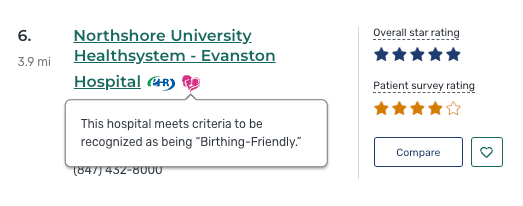Impact
- 22.3 maternal deaths occurred per 100,000 live births in the U.S.
- Roughly 2,200 U.S. hospitals on Care Compare are "Birthing-Friendly"
- 550,000 people use Care Compare each month
Summary
In 2022, the United States’ maternal mortality rate was 22.3 deaths per 100,000 live births — higher than any other developed nation. This is why the Biden-Harris administration has made it a priority to address the maternal health crisis. Part of the administration’s strategy is empowering people who give birth with data on "Birthing-Friendly" hospitals. This means hospitals that are participating in state and federal programs and implementing practices aimed at improving maternal and child health. The Centers for Medicare & Medicaid Services (CMS) partnered with Nava to create a "Birthing-Friendly" indicator for hospitals on Care Compare — CMS’s website that enables Medicare beneficiaries to find and compare providers. This new indicator enables Medicare beneficiaries (under 65 years old) and caregivers to make data-informed decisions about perinatal care, ultimately working toward the Biden-Harris administration’s goal of making the United States the best country in the world to have a child.
Approach
550,000 people use Care Compare each month, and although many of these users are over 65 and not of reproductive age, others are younger Medicare beneficiaries who qualify for the program due to a disability or other illness. Some Medicaid beneficiaries also use Care Compare, and even members of the public without a Medicare account can leverage the resource.
Our shared goal was to design an excellent experience for these populations by making the "Birthing-Friendly" indicator highly visible across Care Compare. In partnership with multiple teams at CMS, we leveraged data analysis, human-centered design, and plain language to meet this goal.
Outcomes
We supported CMS in determining the most effective placement for the "Birthing-Friendly" indicator across Care Compare. People can access this indicator on Care Compare on any device, and can hover over the icon to learn more about the "Birthing-Friendly" designation. As of June 2024, roughly 2,200 hospitals across the U.S. have the "Birthing-Friendly" designation.

A screenshot of the new “Birthing-Friendly” indicator on Care Compare.
Process
In order to determine which hospitals would receive the “Birthing-Friendly” indicator, we worked with CMS’s Center for Clinical Standards and Quality (CCSQ) to report data on hospitals that participated in a statewide and/or national maternal safety quality collaborative program. Once CMS honed the indicator design, we offered guidance on where to place the indicator and how to make it accessible on multiple devices. Lastly, we helped CMS launch the indicator on the Care Compare website and monitored the feature’s performance by tracking key metrics such as interactions with the indicator.
Conclusion
By leveraging data, human-centered design, and plain language, we were able to help CMS connect pregnant people to “Birthing-Friendly” hospitals — an important step to address the maternal health crisis.
Special thanks to Chloe Hilles for contributing to this article.
Written by

Principal designer/researcher and design manager

Product manager

Senior Editorial manager
